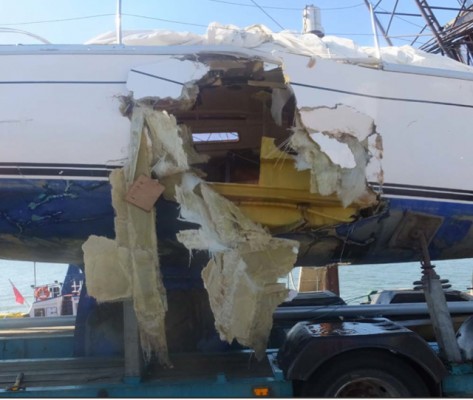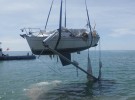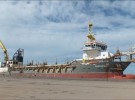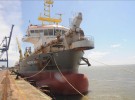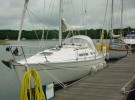Almost a year after a yachtswoman was killed when her cruiser was in collision with a dredger off the coast of Felixstowe, an official report has been published.
At 1331 on 8 June 2014, the dredger Shoreway and the sailing yacht Orca collided seven miles offshore.
Damage to Orca was catastrophic and it sank within minutes of the collision.
The yacht’s skipper was rescued from the water by Shoreway’s rescue boat but the skipper’s wife, Bernadine Ingram, could not be found despite an extensive air and sea search.
The body of Mrs Ingram was recovered from the sunken yacht by divers the next day. There was no damage to Shoreway.
A Marine Accident Investigation Branch (MAIB) investigation has established that:
- The vessels collided in good visibility as neither the chief officer, who was alone on the bridge of Shoreway, nor the skipper of Orca, who was below deck in the cabin, were maintaining a proper lookout during the period immediately prior to the collision.
- Following an alteration of course by the chief officer on Shoreway, Orca entered a blind sector caused by the vessel’s bow-mounted rainbow discharge equipment and remained unseen by the chief officer until seconds before the collision.
- Orca’s skipper saw Shoreway approximately 1.6 miles away and, from its aspect at the time, judged there to be no risk of collision and decided to engage his autopilot and go briefly below.
- Shoreway’s officer of the watch should not have been alone on the bridge at the time of the accident.
- The risks of vessels, especially small craft, not being detected in the blind sector on Shoreway, had never been assessed by the company or the crew and were not mentioned in either the master’s standing orders or the vessel’s safety management system.
- The safety management system on board Shoreway was a computer based fleet-wide generic safety management system that was of little benefit to the ship’s crew as it contained no vessel-specific information, guidance or instructions.
Safety lessons
- It is essential that all vessels maintain a proper lookout at all times. Had the crew of either Shoreway or Orca done so, this collision could have been avoided.
- Leisure boat users should never assume that they have been seen by other vessels, nor should they assume that the other vessels will always take avoiding action. Due to the good visibility, the officer on watch on Shoreway was not using his radar and had not seen the target of Orca that had been visible on his screen for 11 minutes before the collision.
- Leisure sailors need to be particularly aware of closing speeds between their own vessels and other vessels. In this case, Shoreway was travelling at 12.9kts but many types of vessels, including ferries, cruise ships and container ships, regularly sail at speeds over 25kts and, as a result, distances that initially appear sufficient can be reduced surprisingly quickly.
The following four pictures, taken from a stationary vessel, give an indication of how rapidly a vessel, in this case a dredger, can approach.
Orca’s skipper’s automatic inflation lifejacket failed to inflate on immersion in the water as the CO2 bottle was not correctly fitted to the inflation mechanism. To remain effective, inflatable lifejackets must be serviced in accordance with the manufacturer’s guidelines.
Related articles
Dredger officer admits causing fatal yacht crash
Dutch chief mate sentenced for fatal yacht collision
Yacht vs dredger collision: dead yachtswoman named
Actions taken
As a result of the fatality, Harwich Haven Authority has reminded all Pilot Exemption Certificate holders that two qualified watchkeepers should be on the bridge when navigating in the pilotage area, and reminded yacht owners of the importance of keeping a good lookout.
Boskalis Westminster Shipping B.V. has issued a safety message to its fleet emphasising the need to keep a good lookout, and has conducted an internal investigation.
The MAIB has published a safety flyer aimed at leisure boat users, with the safety lessons listed above.
The MAIB report has also made a recommendation that Boskalis Westminster Shipping B.V. should conduct a full review of its fleet’s safety management systems and take action to ensure that any issues identified are fully addressed.
The report’s conclusion states: ‘Orca had generated a clear target that had been visible on Shoreway’s radar display for 11 minutes prior to the collision. Shoreway’s chief officer had not recognised the need to look at the radar or make use of its ARPA function, so Orca’s target had not been seen, acquired or plotted.’
The conclusions added: ‘Orca’s skipper saw Shoreway approximately 1.6nm from Orca and, from its aspect at the time, judged there to be no risk of collision. He then decided to engage his autopilot and briefly go below.’
‘…It is evident that Boskalis should adopt a more proactive approach to developing a more positive safety culture in respect of bridge watchkeeping practices on board its vessels.’




